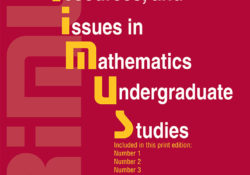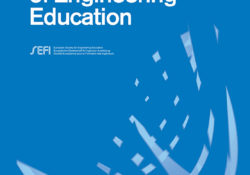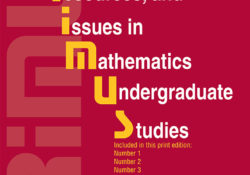eric.ed.gov har udgivet: The concept of project-based learning (PBL) has garnered wide support among a number of K-12 education policy advocates and funders. This working paper builds on and updates a seminal literature review of PBL published in 2000. Focused primarily on articles and studies that have emerged in the 17 years since then, the working paper discusses the principles that underlie PBL, how PBL has been used in K-12 settings, the challenges teachers have confronted in implementing it, how school and district factors influence its adoption, and what is known about its effectiveness in improving students’ learning outcomes. PBL is grounded in cross-cutting “design principles” often related to what is taught, how it is taught, and how students should be evaluated in a PBL classroom. PBL design principles emphasize… Continue Reading →
Like this:
Like Loading...
tandfonline.com har udgivet en rapport under søgningen “Teacher Education Mathematics”: Abstract Abstract This study investigates the hands-joined learning framework as an approach to personalize and provide instructional scaffolding within project-based learning. The authors include a case description of hands-joined learning in a middle school social studies classroom and critically examine middle school student feedback in relation to two aims: (a) personalizing learning, and (b) providing adequate scaffolding. Student feedback indicated that the hands-joined learning project was largely successful in these two areas. Learners appreciated having choice and control in what they learned and created in the project but also pointed to the need for greater opportunities to make decisions in how they learned. Some learners also wanted more peer interaction. These findings are used to propose practical implications as well… Continue Reading →
Like this:
Like Loading...
tandfonline.com har udgivet en rapport under søgningen “Teacher Education Mathematics”: ABSTRACT ABSTRACT Can you ask students from three different bachelor programmes to help solve planning and routeing problems for hospitals? In the presented case an interdisciplinary approach was shown to be successful after some redesign. Students from Applied Mathematics, Civil Engineering and Industrial & Engineering Management jointly designed solutions for ‘traffic’ to and through the hospital using stochastic modelling. Importantly this project was scaffolded through coursework, supervision and problem-design. The particular scaffolding strategy employed by the teaching team offers other teacher teams ideas for making interdisciplinary project-based learning a more effective learning opportunity. At the same time we need to ensure that students feel at home in their own programme and will be empowered to work with other specialists. Link… Continue Reading →
Like this:
Like Loading...
eric.ed.gov har udgivet: As schools work to implement the Next Generation Science Standards (NGSS), a team at Stanford University found that project-based learning is an effective framework for engaging students. The team used project-based learning, group activities, and performance-based assessments to design an effective, engaging curriculum. Over a three-year period, the team conducted research which showed that the curriculum led to gains in both student engagement and learning outcomes (as measured by the Smarter Balanced Assessment Consortium’s math and English language arts tests, the California English Language Development Test, and a science pre- and post-assessment). The team contends that these gains were supported by a curriculum and professional development package that led to changes in teachers’ instructional practices. It highlights five things to look for when evaluating NGSS instructional materials… Continue Reading →
Like this:
Like Loading...
eric.ed.gov har udgivet: This paper reports on initial data from teachers at an Australian Year 9-12 secondary school which is attempting to implement a project-based learning model across the entire curriculum. The eight teachers had diverse prior teaching experiences, including work in primary schools, special education, Year 7-10 secondary schools, and technical and further education. None had studied mathematics at tertiary level and just one listed maths as a main teaching area. Results of an initial survey indicate that most had reasonable levels of personal mathematics competence, and could identify relevant mathematical concepts among the affordances of a particular scenario, but that they struggled to articulate how they would work with students to pursue any of the relevant mathematics in depth. [This project was funded by University of Tasmania Research… Continue Reading →
Like this:
Like Loading...
tandfonline.com har udgivet en rapport under søgningen “Teacher Education Mathematics”: Abstract Abstract Ideally, students of mathematics gain much from their coursework and undergraduate careers. If we (teachers and professors) do our jobs right, then math majors and minors should, among other achievements, gain the ability to apply their mathematical knowledge to other disciplines and real-world problems. Project-based learning offers one way to achieve this goal, as it encourages students to solve interdisciplinary problems that arise outside of the traditional classroom. Project-based learning can be implemented as part of a class or as an enrichment program, and it typically features problems arising from a variety of sources (including social concerns of different communities, demands from business and industry, and non-profit or government organizations). In this special issue on Project-Based Curricula, we… Continue Reading →
Like this:
Like Loading...
tandfonline.com har udgivet en rapport under søgningen “Teacher Education Mathematics”: Abstract Abstract The Mathematics Practicum has been offered at St. Olaf College for over 30 years. The Practicum is a 4-week, January Interim course where three teams of five students work on consulting problems solicited from area businesses, government agencies, and non-profit organizations. These problems have significant mathematical, statistical, and computational components. The projects end with a professional-quality student presentation at the client’s home office. This project-based, interdisciplinary, experience encourages problem solving, collaboration, inquiry, and communication skills. We discuss the logistics of the course, key factors that make this a positive experience for both the students and the sponsoring organizations, continuing challenges, and benefits to the students. Link til kilde
Like this:
Like Loading...

tandfonline.com har udgivet en rapport under søgningen “Teacher Education Mathematics”: Abstract Abstract James Madison University faculty team-teach an interdisciplinary mathematical modeling course for mathematics and biology students. We have used two different project-based approaches to emphasize the mathematical concepts taught in class, while also exposing students to new areas of mathematics not formally covered in class. The first method allows students to select projects based on their individual interests, which provided the class with an exposure to the breadth of applications of mathematical modeling to biology. The second method allows students to select projects that are focused around one common biological theme, which encouraged a remarkable cohesion among the whole class. These strategies could be extended to various applications-based mathematics courses. We present our observations and make recommendations for project-based… Continue Reading →
Like this:
Like Loading...




